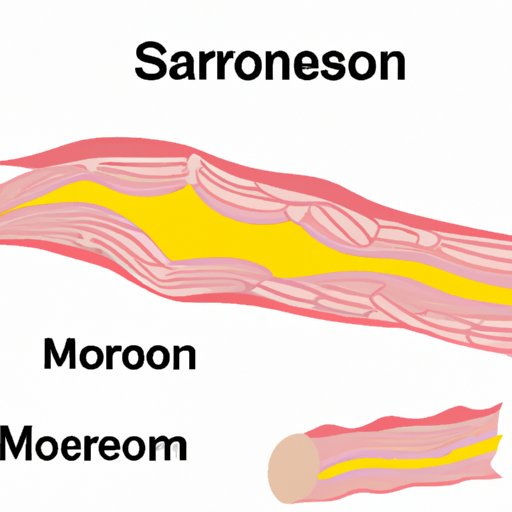I. Introduction
The sarcomere may sound like a fancy scientific term, but it’s actually a foundational component of muscle contraction. Understanding what a sarcomere is and how it works can shed light on how our muscles function and how to optimize their performance. In this article, we will delve into the anatomy, function, and impact of the sarcomere on muscle contraction.
II. Anatomy 101: Understanding the Sarcomere and Its Role in Muscle Contraction
At its most basic level, a sarcomere is a unit within a muscle fiber that is responsible for muscle contraction. It’s located between two Z-discs, which anchor the sarcomere in place. The sarcomere is made up of several proteins, including actin and myosin, which work together to create muscle movement.
The sarcomere functions by contracting and relaxing in response to stimulation from nerve impulses. The actin and myosin proteins interact to create a sliding movement, which shortens the sarcomere and causes muscle contraction.
The sarcomere is an essential component of muscle function, as it enables muscles to generate force and produce movement. Without properly functioning sarcomeres, our muscles would be unable to contract and relax, which would significantly limit our movement capabilities.
III. From Actin to Myosin: A Comprehensive Guide to the Inner Workings of the Sarcomere
Actin and myosin are the primary proteins involved in the movement of the sarcomere and muscle contraction. Actin forms thin filaments that are anchored to the Z-discs, while myosin forms thick filaments that are located in the center of the sarcomere.
When the sarcomere receives a nerve impulse, calcium ions are released, which bind to the protein troponin. This causes a conformational change in tropomyosin, which exposes the binding sites on actin. Myosin then binds to actin, forming “cross-bridges” that pull the actin filaments towards the center of the sarcomere.
As the myosin heads “walk” along the actin filaments, the sarcomere shortens, causing muscle contraction. This process is repeated many times, resulting in sustained muscle contraction as long as the nerve impulse continues.
The interaction between actin and myosin is crucial for muscle function, as it allows our muscles to produce the force necessary for movement. Without this interaction, our muscles would not be able to contract or produce movement, severely limiting our physical capabilities.
IV. Breaking Down the Sarcomere: How It’s Studied and Why It’s Important in Physiology
There are several ways to study the sarcomere and its function, including microscopic imaging techniques and biochemical assays. Studying the sarcomere is important in physiology because it provides insight into muscle function and can help to identify the root causes of muscle diseases and disorders.
For example, researchers have used sarcomere studies to identify genetic mutations that cause muscle diseases such as muscular dystrophy and myopathies. These studies have also revealed how changes in sarcomere function contribute to age-related declines in muscle mass and strength.
By understanding the sarcomere at a molecular level, researchers can develop targeted therapies and interventions for muscle disorders and injuries. This knowledge can also help athletes and fitness enthusiasts understand how to optimize their training regimens for optimal muscle function.
V. All You Need to Know About the Sarcomere: Structure, Function, and Impact on Exercise Performance
Optimizing sarcomere function can improve exercise performance and reduce the risk of injury. By engaging in exercises that stress and challenge the sarcomeres, individuals can strengthen their muscles and improve their overall physical capabilities.
One effective way to optimize sarcomere function is through resistance training, which involves lifting weights or using resistance bands to challenge the muscles. This type of training stimulates the sarcomeres to adapt and grow stronger, resulting in improved muscle function and endurance.
Other ways to optimize sarcomere function include incorporating regular stretching to maintain muscle flexibility, getting adequate rest and recovery to allow the muscles to repair and rebuild, and consuming a balanced diet with adequate protein to support muscle growth and repair.
VI. Muscle Function 101: The Sarcomere and Its Crucial Role in Skeletal Muscle Contraction
The sarcomere is a fundamental component of muscle function, and understanding how it works is essential for anyone interested in exercise or muscle health. By optimizing sarcomere function, individuals can improve exercise performance, reduce the risk of injury, and maintain overall muscle health.
Additionally, understanding the sarcomere can help individuals identify potential muscle disorders or injuries and seek appropriate treatment. Whether you’re an athlete, a fitness enthusiast, or simply someone interested in maintaining overall physical health, understanding the sarcomere is an essential part of achieving your physical goals.
VII. Conclusion
The sarcomere is a vital component of muscle function and plays a critical role in our ability to move and perform physical activities. By understanding the anatomy, function, and impact of the sarcomere, individuals can optimize their muscle performance and reduce the risk of injury.
Whether you’re an elite athlete or simply someone interested in maintaining a healthy lifestyle, incorporating strategies to optimize sarcomere function can help you achieve your physical goals and maintain overall muscle health.
